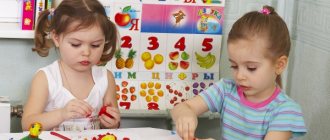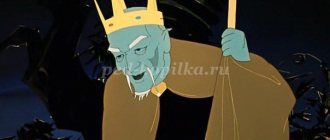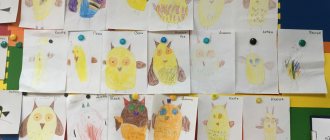MAGAZINE Preschooler.RF
“Magic Modeling” program for the senior groupGoal: Development of creative abilities in children of senior preschool age.
Objectives of the circle: introduce children to unconventional modeling techniques, coloring finished products; consolidation of knowledge about Dymkovo, Khokhloma, Gzhel paintings; fix relief, volumetric modeling; introduce the technique of making salt dough products; to develop an interest in performing creative works using different materials and methods; consolidate children's knowledge of materials that can be worked with and be able to use them correctly.
Explanatory note:
Our time requires creative, non-standard people who think and act for the benefit of the development of the individual and society. Therefore, the social order of society is to develop children’s creative abilities, the ability to think outside the box, not to be afraid to express opinions that differ from the generally accepted, to see the unusual in the ordinary.
According to psychologists and teachers, preschool age is the most favorable for the development of thinking and imagination - a mental process that forms the basis of creative activity. Therefore, the development of creativity is one of the main tasks of preschool education and upbringing.
The use of non-traditional modeling techniques in the practice of working with children works to solve several developmental problems at once:
- development of children's creative abilities (in all the diversity of this concept);
- development and improvement of fine finger motor skills;
- developing skills and abilities to work with various materials, devices and tools;
- acquaintance with new techniques and technologies;
- ability to apply them in practice.
Frequency of the circle: once a week for one academic year.
Duration of the circle: 25 minutes.
Expected student results:
Sculpts objects of various shapes using learned techniques and methods of sculpting;
Creates small plot compositions, conveying proportions, poses and movements of figures.
Creates images based on folk toys.
September:
1. Topic: “Apples and pears.” Gifts of autumn. Signs of autumn.
Goals and objectives: Practice rolling a ball, oval, flattening, using natural material to complement the craft.
Materials and equipment: Salt dough, dummies of fruits, stacks,
reproduction of paintings with fruits. (1/59)
2. Theme: “Sunflower”
Goals and objectives: Practice rolling a ball, oval, flattening, using natural material to complement the craft.
Materials and equipment: Salt dough, photo of a sunflower, stack, seeds. (11/14)
3. Theme: Decorative plate “Rose”. Gifts of autumn.
Goals and objectives: To develop the ability to sculpt a rose from individual parts, roll out balls, flatten, and make a flower of 6-8 petals. Develop finger flexibility and learn to see the end result.
Materials and equipment: Clay, stack (11/20, 3/61)
4. Topic: Painting the decorative plate “Roses” in the Gzhel style
Goals and objectives: To introduce children to folk art. Continue to develop the ability to paint products after drying, select paints, mix, to obtain the desired shade. Place the work on a plate.
Materials and equipment: Gouache, brushes, palette, dishes with Gzhel painting (8/85)
October:
1. Topic: “Prickly hedgehog.” Animal behavior in autumn.
Goals and objectives: Separately sculpt needles in the shape of a cone, connect the parts. Supplement the work with fungi and apples.
Materials and equipment: Colored salt dough, stack, slide with a picture of a hedgehog in the forest in autumn (11/12)
2. Topic: “The horse is beautiful, daring”
Goals and objectives: Continue to introduce children to folk art. Model a horse from a whole piece of clay. Develop finger flexibility and learn to see the end result.
Materials and equipment: Clay, stack, water, photo of the Filimonovsky horse (2/56)
3. Topic: “Kargopol goat”
Goals and objectives: Continue to introduce children to folk art. Model a horse from a whole piece of clay. Develop finger flexibility and learn to see the end result.
Materials and equipment: Clay, stack, water, photo of the Kargopol goat (1/112)
4. Theme: “Elephant”
Goals and objectives: Strengthen the ability to sculpt three-dimensional things and develop motor skills.
Materials and equipment: Plasticine, stack, photo of an elephant, sample of an elephant (5/14)
November:
1. Topic: “Ladybug” (on a leaf)
Goals and objectives: Learn to sculpt a ladybug from parts: head, body, using moldings, additional material for decoration. Use a leaf cutter. Be able to regulate the pressure when performing moldings.
Materials and equipment: Salt dough, leaf mold, toy, water, brush (12)
2. Topic: Coloring with “Ladybug” paints.
Goals and objectives: To develop skills of accuracy when coloring work. Be able to use unconventional drawing skills - with your finger, to draw dots. Exercise in ways of working with paints, designing work on a piece of paper.
Materials and equipment: Gouache, brush, glue (12)
3. Topic: “Panel with flowers” (sgraffito).
Goals and objectives: Familiarization with the technique of sgraffito - “scratched” on plasticine. plasticine,
Materials and equipment: cardboard, stack, painting with flowers
4. Topic: “Penguins on an ice floe.”
Goals and objectives: Continue to develop the ability to sculpt a figurine from a whole piece, using the techniques of rolling, stretching, flattening, cutting in stacks, conveying their characteristic features and proportions. Use foil when sculpting the body. Develop children's imagination and intelligence.
Materials and equipment: Salt dough, foil, foam. (11/8)
December:
1. Topic: Coloring with paints “Penguin on an Ice Floe”.
Goals and objectives: Continue to develop children’s ability to paint figures after drying, to combine them into a common composition. To develop children’s ability to accurately convey a conceived idea when coloring a product.
Materials and equipment: Gouache, brush, glue. (11/8)
2. Theme: “Christmas tree under the snow” (relief modeling)
Goals and objectives: Introducing children to a new modeling technique - plasticine stretching. Materials and equipment: plasticine, stack, card with Christmas tree (13)
3. Theme: “Snow Maiden”
Goals and objectives: To learn to reflect the impressions received while observing winter nature. Develop artistic and creative abilities.
Materials and equipment: Clay, model of the Snow Maiden (10/24)
4. Topic: Painting the Snow Maiden with Gzhel paintings.
Goals and objectives: Repeat the “Gzhel” painting with the children. Exercise in ways of working with paints, develop aesthetic perception and sense of color. Continue to develop the ability to see the end result of the planned work.
Materials and equipment: Gouache, brush, palette. Folk painting “Gzhel” (8/85)
January:
1. Theme: “Elegant Christmas tree”
Goals and objectives: To develop the ability in children to cut out a Christmas tree using a stencil, smooth out the edges with a brush moistened with water, and independently come up with decorations - balls, toys, beads. Develop finger flexibility. Use familiar sculpting techniques in a new creative situation.
Materials and equipment: Salt dough, “Christmas tree” stencil made of cardboard, stack, beads. (17)
2. Topic: Coloring with paints “Elegant Christmas tree”.
Goals and objectives: Continue to develop the ability to paint a Christmas tree with paints, develop skills of accuracy when doing work. Develop creative imagination and coherent speech when writing stories about the Christmas tree. When decorating the Christmas tree, use various additional materials
Materials and equipment: Gouache, brushes, glue, threads, beads, confetti. (17)
3. Topic: “Kargopol horse”
Goals and objectives: Continue to develop the ability to sculpt from a whole piece of clay.
Materials and equipment: clay, stack. (7/8)
4. Topic: “Decorating the Kargopol horse.”
Goals and objectives: To practice ways of working with paints, to develop aesthetic perception and a sense of color. Instill a love for animals and a desire to help them.
Materials and equipment: Gouache, brush, palette (7/8)
February:
1. Topic: “Bear-folk toy”
Goal: Continue to strengthen the ability to sculpt from a single piece. Introduce the traditions of potters.
Materials and equipment: plasticine, stack (9/10)
2. Topic: “Mug for Dad.”
Goals and objectives: To develop children’s ability to sculpt a mug, roll out plasticine in the form of a strip, a ball, press a depression in it, and pinch the edges. Sculpt the initial letter of the name for decoration. Develop fine motor skills and imagination in decorating a souvenir. Materials and equipment: Plasticine, stack (6/28)
3. Theme: “Hearts”
Goals and objectives: Consolidating the ability to sculpt objects or parts of them from dough, using the movement of the entire hand.
Materials and equipment: Colored salt dough, water
4. Topic: “Stork on the roof.”
February: Practice “painting over” a picture with plasticine. Cultivate an interest in creativity.
Materials and equipment: Plasticine, cardboard, cards with migratory birds, encyclopedia about birds (15)
March:
1. Topic: “Four-legged friend”
Goals and objectives: To develop the ability to use knowledge about the features of the appearance of animals in their work. Strengthen the skills and abilities acquired earlier (rolling, flattening, pulling, smoothing edges). Develop creative imagination and interest in work.
Materials and equipment: Stacks, plasticine, cardboard (10/28)
2. Topic: Signs of spring.”Flower meadow.”
Goals and objectives: Improving manual labor skills by modeling from colored dough.
Materials and equipment: Colored dough, stacks, water, slides with spring flowers (11/14)
3. Theme: “Basket with flowers”
Goals and objectives: Continue to develop children’s ability to roll out clay in an even layer, cut out a basket using a stencil, and scratch with a fork. Tie the flagella together for the handle and bottom. Sculpt familiar flowers and leaves. Develop imagination and the desire to give joy to others.
Materials and equipment: Clay, fork, basket stencil, stack. (11/14)
4. Topic: Coloring the basket and flowers.
Goals and objectives: To cultivate interest in creativity, collectivism, and aesthetic perceptions.
Materials and equipment: Gouache, brush. (11/14)
April:
1. Topic: “Amazing underwater world” (plasticineography)
Goals and objectives: Introduction to non-traditional drawing techniques (plasticine).
Materials and equipment: plasticine, stack (11/26)
2. Topic: “Rocket”.
Goals and objectives: To develop the ability to make a cone-shaped shape. Develop fine motor skills of the hands.
Materials and equipment: Salted dough, stack. Rocket photo (14)
3. Theme: Geometric man
Goals and objectives: Continue to develop children’s ability to paint crafts after drying, selecting the right colors. To develop the ability to accurately convey a conceived idea when coloring a product, to reveal the creative imagination of children in the process of work.
Materials and equipment: Clay, skewer, paints, brush (6/14)
4. Topic: “My dad is a fireman”
Goals and objectives: Continue to develop the ability to sculpt funny little people using the techniques of rolling balls, ovals, flattening, and pulling. Use matches and sticks to connect the parts. Develop the ability to work collectively.
Materials and equipment: Clay, matches, sticks, stacks (2/79)
May:
1. Topic: “St. George’s Ribbon.”
Goals and objectives: To develop the ability to roll out clay with a rolling pin and cut out shapes according to a template. Cultivate an interest in creativity.
Materials and equipment: Plasticine, template, stack
2. Theme: “Clover”
Goals and objectives: To consolidate the ability to roll balls of different sizes. Continue learning how to apply a relief pattern using a stack.
Materials and equipment: Plasticine, template, stack (3/38)
3. Topic: “Circus in Samara.”
Goals and objectives: Continue to develop the ability to notice and convey in modeling the characteristic features of an architectural structure.
Materials and equipment: Plasticine, stack, circus photo (16)
4. Topic: “Children on a walk.”
Goals and objectives: Continue to teach children how to convey movement in sculpting.
Materials and equipment: Plasticine, stack. (2/80)
Bibliography:
- Bondarenko T.M. “Complex classes in the senior group of kindergarten.” EC "Teacher", Voronezh, 2007
- Volchkova V.N., Stepanova N.V. “Lesson notes for the senior group of kindergarten”, Voronezh, 2008
- Davydova G.N. “Plasticineography. Floral motifs", M., 2009
- “From birth to school”, edited by N.E. Veraksy, T.S. Komarova, M.A. Vasilyeva M., Mozaika-synthesis, 2014.
- Petrova O. “Animals made of plasticine.” FST-PRESS KNIGA LLC, M., 2013
- Plomer A.L. “Making from clay” Kharkov, 2013
- Educational publication “Art for children. Kargopol toy. ed. "MOSAIKA-SYNTHESIS", M., 2008
- Utkin P.I. "Folk artistic crafts of Russia." M., 1984
- Educational publication “Art for children. We are making a folk toy.” ed. "MOSAIKA-SYNTHESIS", M., 2010
- Educational publication “Art for children. Khokhloma painting". ed. "MOSAIKA-SYNTHESIS", M., 2010
- Firsova A “Miracles from salt dough.” LLC "AIRIS-press", M., 2013
| Next > |





